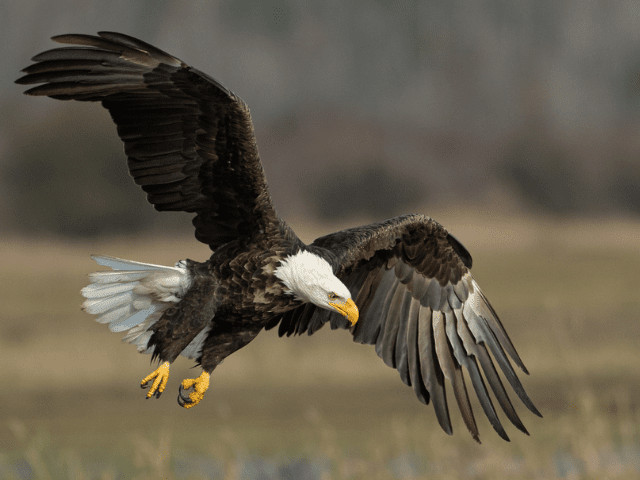That special place where the sea meets the land can seem uncertain and draws the attention of many.
Most bird enthusiasts know Florida has eye-catching beaches, rocky mountains, and impressive mangroves.
Birds of different kinds are likely to live in these areas.
So...
If you happen to be around the state, you may be lucky enough to see some Florida birds of prey too.
Let's satisfy that curiosity as we dive deep into details about the diversity of these bird species. A profound understanding will allow more appreciation of these birds' beauty and their roles in the ecosystem.
A Closer Look At The Florida Birds Of Prey
New birders should invest more time getting familiar with wildlife. It will take some getting used to becoming an expert in bird identification. You're at the right page if this is what you're trying to do.
Take a closer look at each predatory bird we can name in the state and see what makes them captivating. Maybe when you're somewhere in the area around Pomacocha, you'll have a better idea of what migratory birds you might experience there.
1. Bald Eagle
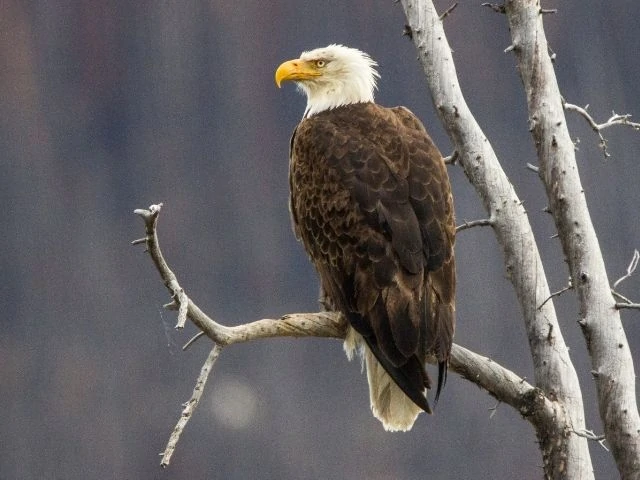
There are many birds of prey in Florida, including the majestic bald eagle with its loud voice throughout the year. Thanks to its striking white head and tail, you will find this large-sized raptor all year round in the state with no trouble.
The eagle's body and wings are a combination of brown and black, with an arched yellow mandible and feet. Unlike other preying birds, this eagle uses its bill as eating utensils and not as a weapon.
You might be in awe to find out that its female is more prominent in size than the males of its kind.
It is somewhat rare in the state as widespread as this eagle is due to its dramatically declining population. You have better chances of coming across this kind in wetlands, scavenging dead animals, or targeting an osprey.
This eagle typically consumes fresh fish, identical to a brown pelican and an American white pelican. But they can thrive well as the bald eagles can exploit various food options.
2. Peregrine Falcon
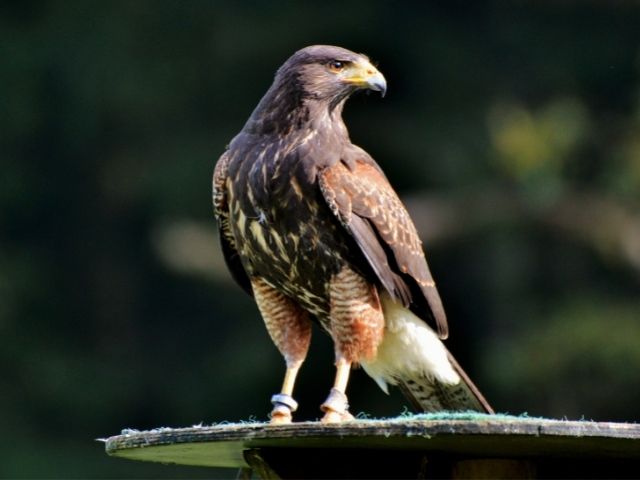
If you ever heard about a Florida bird that won't mind migrating to South America merely to learn about catching city pigeons, that's the Peregrine falcon. Hence, its reputation of being "the wanderer." It would eventually spend all winter in the North.
Afterward, it will grab the prey before hitting the ground. As a result, it became famous as a bird with the fastest freefall flight.
Further, you can readily identify this handsome falcon with its dark head and dark spots on its light buff breast. It has a bright yellow eye-ring, bluish-gray upperparts, and yellow toes. This falcon's prey varies from large mammals to insects. Occasionally, it also eats a small bird.
3. Great Horned Owl
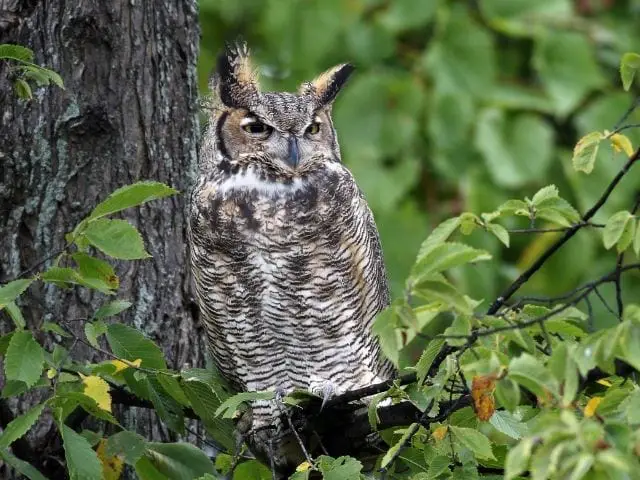
There is no doubt that the great horned owl is the largest widespread owl species, but you will rarely encounter it.
However, it would be wise if you didn't let this bird's seemingly harmless look deceive you. A great horned owl is reputable for its ferocity, and it even kills hawks and occupies their nests. But as greedy as it is, this type of owl has a pretty diverse diet.
It will feed on anything from other raptors like the barred owl, reddish egret, snowy egret, porcupine, housecat, and geese. This owl also loves recycling the nests of other birds but will never create its own.
Moreover, this symbolic owl depends on a wide range of environments, from urban areas to plains and forests in general. A creature like this and different kinds of owls, for that matter, excrete their food's indigestible remains as an owl pellet.
Pellets like these are often mistaken for droppings from foxes. Typically, they are oval-shaped, dark objects having hair, feathers, insect parts, and bones.
Fun Fact: Did you know that the Great Horned Owl is also one of the more common owls in New Jersey?
4. Crested Caracara
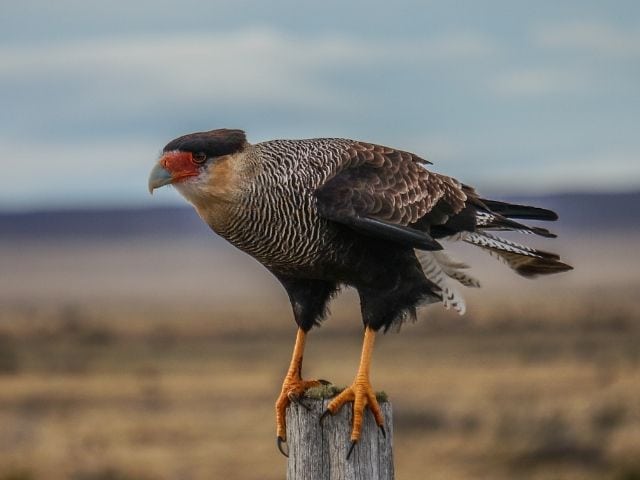
The crested caracara is also a part of the falcon family, although its kind differs in form and behavior. This caracara is a Florida bird you won't typically find in the rest of the country. Most of the time, it is foraging on the ground or creating nests.
This ravening bird mainly feeds on carrion and small mammals, including snakes and insects. It attacks its prey when immobile or injured, making this bird kind the supreme opportunist.
Moreover, it ousts a black vulture from feeding on carrions; in the same way, the turkey vulture also supersedes the black vulture. It is a striking bird with its exotic combination of black and white shade in its body, a crooked bill, and a bare red face.
The white wingtips and tail are exceptional when it's in flight. It often inhabits the open woodland or the grassland. You may also see them perching on poles sometimes.
5. Mississippi Kite
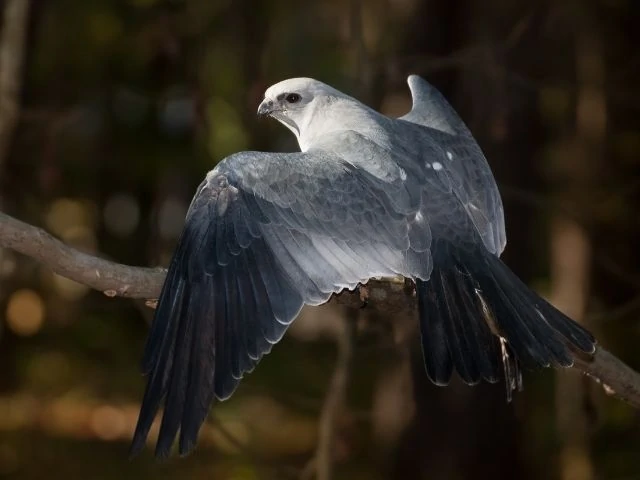
This bird of prey is among the rare migratory birds and an unusual breeder. In summer, you will find this species throughout the United States before migrating towards the South in winter. It also belongs to the Accipitridae family, like the hawks and eagles.
When identifying this bird, you will first notice its dark gray upper wing and a slate gray shade across its back. In comparison, the rounded head of this kite appears to be paler, almost white, with a dark eye patch and red eyes.
Furthermore, you will rarely see this bird perching on trees because it usually soars gracefully through the skies. It generally feeds on insects they catch when in flight.
6. Coopers Hawk
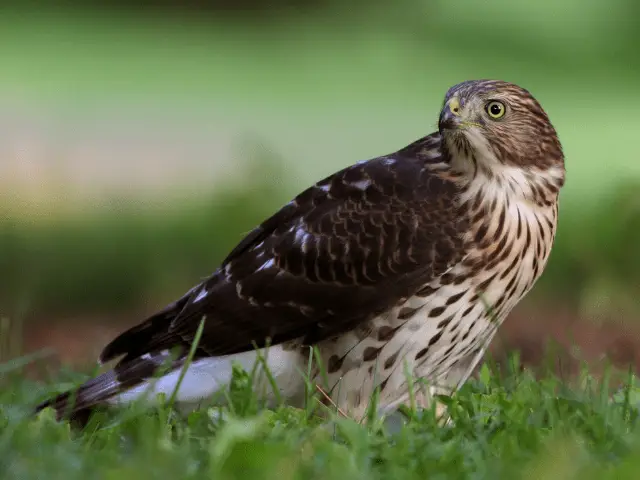
This hawk type is well-known for being notorious for exploiting bird feeders. Some of their kind will stay North, while others migrate to Central America to hunt for food sources like warblers, tanagers, and orioles. In addition, the cooper preys on Northern cardinals.
This sly bird can easily find its way even in lush vegetation. You will now see a lot of these hawks in the urban area.
Grayish-blue upperparts, white bands on the tail tips, a dark head, and reddish eyes mark this hawk as distinctive. It shares distinct similarities with the Northern harrier and the sharp shinned hawk.
Additionally, a cooper's voice sounds like a typical staccato, including 40 various calls. This bird also finds large deciduous trees suitable for nesting. Aside from inhabiting urban areas, you will likely see this hawk suddenly dropping from trees to capture unsuspecting prey.
7. Burrowing Owl

It is unlikely to see a burrowing owl breeding in urban habitats these days. Nesting success is rare among their kind in natural habitats, so it's not surprising to see them in urban areas. You might often find this owl benefiting from ground burrows made by rabbits or rodents.
You will quickly recognize this owl with its small flat-shaped head, long legs with bristled toes, and yellow eyes with no ear tufts. Its upper section has brown plumage with white spots, while the underparts are extensively barred brown and white.
You might even notice them making a bowing movement as you pass by or approach them.
Unfortunately, this owl species' population is declining in some areas due to road deaths and prairie dogs and ground squirrels extinction. These animals' burrows are crucial for the survival of these burrowing owls.
8. Barn Owl
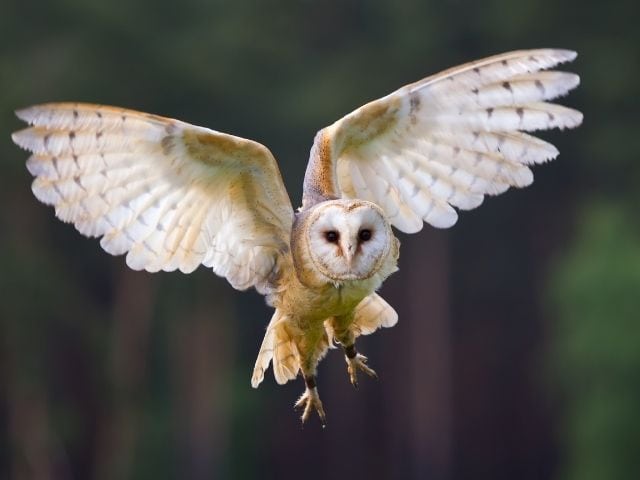
The barn owl family is well-known for exhibiting distinctive threat displays. When facing an intruder, the owl will bow forward, open its inclined wings while unfurling its tail.
After that, it will sway or nod its head, hiss, and snap with its bill. Additionally, it uses its claws to attack and shoot droppings at potential enemies.
Studies show barn owls can catch a mouse in total darkness by hearing alone. For this reason, many farmers consider this mainly nocturnal bird type as their friend. It likes living near farms to hunt mice and rats, but any secure and quiet shelter will do.
This owl has a more pronounced, heart-shaped facial disk with small dark eyes, long legs, light brown wings, back, and tail. In addition to its rusty-colored rear, you will see it with some faint gray smudge and tiny white spots.
9. Eastern Screech Owl
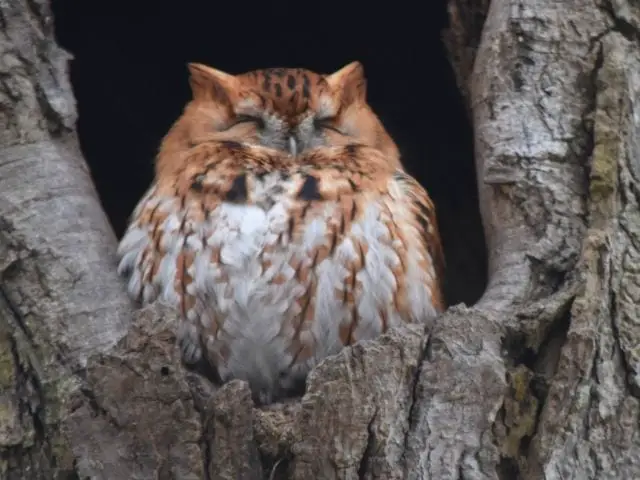
The Eastern screech owl is similar to its Western counterpart, except for an olive-colored bill. It's a pint-sized tufted owl with a big head, a short tail, and bright yellow eyes. This bird wades in the air and has a whinnying call, far from sounding like a screech, as its name would suggest.
This creature's special diet includes a small mammal and an aquatic invertebrate like a small fish. It even feeds on smaller birds.
This screech owl can even catch fish with its feet first in shallow water. Typically this species would scan for its target from tree perches before it swoops down onto its victims.
10. Great Blue Heron
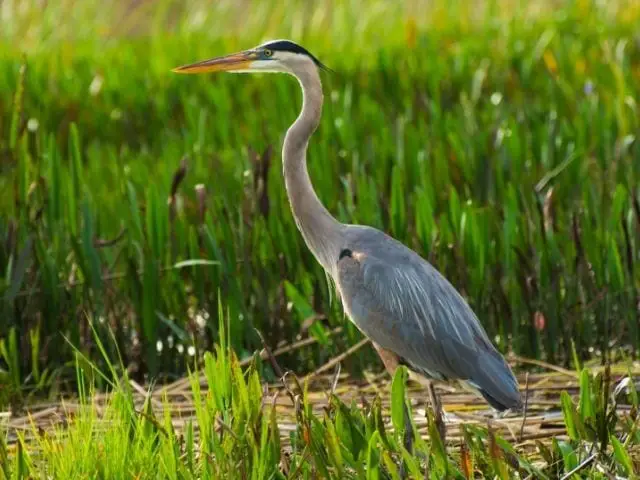
If you happen to see a bluish-gray bird with a buffed, long neck and a white face, that could be the great blue heron. It also has a yellow-orange beak, long legs, and a long black crest. Those who aren't active in the birding community call it the blue crane.
It's easy to spot this heron anywhere there's water nearby because it enjoys hunting fish. The bird also preys upon frogs, crabs, and small mammals using its enormous bill in swamps, marshes, or along sea coasts.
This heron is comparable to the smaller tricolored heron, except that the latter has a white belly. It's also often mistaken for the green heron, which is much smaller and has a shorter neck. But this heron has a majestic upright position, with a striking outstretched neck when in flight.
Unlike other birds of prey, this heron is not as easily visible due to its dull color. But you can locate it with its distinctive voice when in breeding colonies or when disturbed, sounding like a barking squawk.
11. Red-Shouldered Hawk
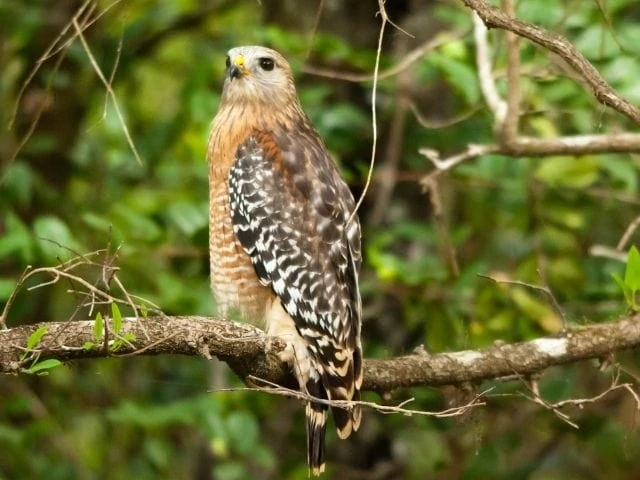
The East part of the US is home to four species and two subspecies of raptors that you can only find in Florida. They are tropical and subtropical in origin, so they only have a limited range due to their habitat and temperature.
In Central and Southern America, there are four types of widespread birds in their subtropical and tropical zones. These birds include a white-tailed kite, crested caracara, snail kite, and short-tailed hawk.
The red-shouldered hawk has the palest color of these subspecies, featuring a rust-colored head and shoulder and barred undertail. Its back and wings have a dark brown shade with some white spots and have a long tail.
You will mostly see this hawk perching in silence and then flying towards its prey. It feeds mainly on small animals and favors bottomland woods where streams are nearby or within wooded residential neighborhoods.
12. Swainsons Hawk
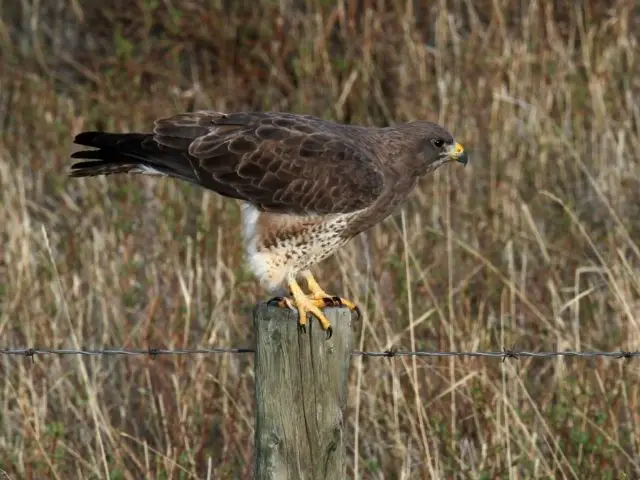
One distinctive trait of a Swainsons hawk familiar to many birders is hunting from an artificial perch, like a power line or telephone pole. The Swainson is among the migratory birds you can encounter in Florida.
Like the bald eagle, a Swainson female is larger-sized than its male. It has a white face, a long tail, and long wings with pointed tips. Since this bird comes in two forms, the lighter ones have white undersides, faint red upper chests, dark brown backs, and white underbellies.
The darker form of this hawk has its breast and belly in dark brown or scarlet, with its undertail coverts looking pale in color. Both forms prey on birds, snakes, and rodents when raising their juveniles, but mostly it prefers large-sized insects.
For this reason, you would typically see this hawk scanning the ground for grasshoppers or caterpillars.
This bird may not be an easy find around the state, but if you're lucky, you might come across it in the Florida Keys, which is an excellent spot for observing migratory hawks in Florida.
13. Broad Winged Hawk
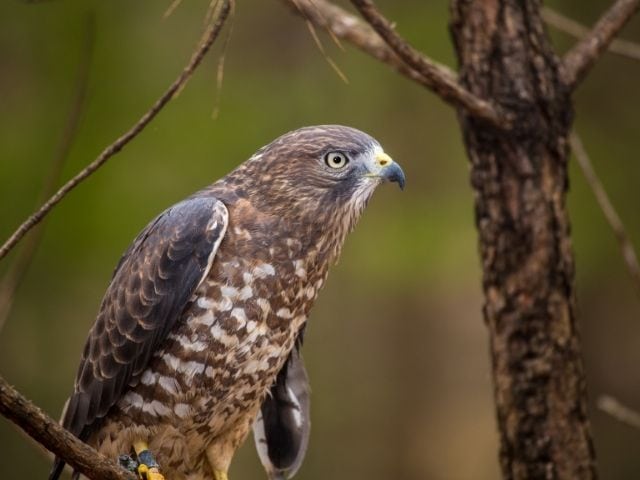
Birds of prey, such as broad-winged hawks, find safety in numbers. These hawks migrate from North America to South America every fall in huge flocks. And as they're nearing Central America, these raptors fly even closer together.
Here's a short video of broad-winged hawks flocking during migration:
The Bon Secour NWR and Dauphin Island are some of the best places in Florida you might want to visit to watch this hawk in migration.
This creature likes breeding in deep woods, being an exclusive forest inhabitant. Their kind only becomes more visible to birders when they're soaring in the sky. You can recognize this bird with its light brown shade with white spots on the chest.
This hawk is among the smaller birds of its kind that inhabit forests with broad-leaved trees. Sometimes a Northern cardinal will imitate a broad-winged hawk's call. It's likewise among raptors with genetic variation resulting in light morphs and dark morphs.
14. Golden Eagle

If there were a raptor popularity contest, I'm pretty confident how the golden eagle would bag the top rank. You can even see this bird on the flags of Germany, Albania, Kazakhstan, Austria, and Mexico.
You will notice how this eagle has large nostrils, so it does not need to keep out water. It also has an exceptionally long hind claw, allowing this bird to carry large prey easily.
A golden eagle's wing is slightly bent at the ends when it glides; this large-sized raptor has a golden patch at the back of the neck. This creature also likes to dwell in outlying areas far from humans. It has an impressive ability to survive in various habitats.
This eagle's primary hunting method involves perching on trees and scanning for its prey. It will swoop down at a remarkable speed of 150 miles an hour once the eagle spots its target.
Rabbits and grouse are part of this eagle's diet; it even feeds on dead farm animals and carrion in winter.
Frequently Asked Questions
What owl-like hawk can you find in Florida?
A Northern harrier is a raptor with a distinct owl-like face disk that you can find during winter in Florida. Many bird enthusiasts also refer to it as the "Marsh Hawk," which is predominant around the local wetlands and adjacent areas.
Some would even mistake it for a snail kite, which has a noticeable white base on its tail when in flight. In contrast, the Northern harrier has a white rear.
Which Florida’s raptors are migratory?
There are various bird types you can witness in migration over the blue skies in Curry Hammock State Park and several other spots in Florida. These birds include a broad-winged hawk, Northern harrier, Peregrine falcon, bald eagle, merlin, swallowed-tail kite, and more.
How do you deal with an aggressive predatory bird?
There are times when the wildlife conservation committee in Florida will receive information about some hawks diving at humans. Such incidents often happen during the nesting season, when chicks or eggs are in an active nest. Attacks like that are a raptor's attempt to protect its nest, whether we're talking about hawks or falcons.
Some of the birds well-known for their aggression towards humans are red-tailed hawks, red-shouldered hawks, cooper's hawks, Swainson's hawks, broad-winged hawks, and peregrine falcons. As a general rule, avoid harming or getting near an active nest. You can also try lowering your gaze to avoid directly staring at any of these birds. Such a gesture can help you gain a sensitive raptor's trust eventually.
What is the most common hawk in Florida?
The red-tailed hawk is a prevalent and adaptable bird that is the most common hawk species across its range in North and Central America. You will often spot this large-sized hawk frequenting neighborhoods, farms, and homesteads. While this bird seldom creates flocks the way robins do, you might have a chance to see it in pairs while catching squirrels by guarding opposite sides of the same tree.
Final Thoughts
In summary, wetland ecosystems in Florida are the most diverse, providing a haven for rare birds. It has swamps, subtropical marshes, mangrove forests, and other habitats.
You will find it enthralling how Florida holds a range of bird types you can't find in other places. Thus, making the state one of North America's most lasting birding destinations. As such, bird watching in Florida becomes even more fun.
Now that you know what birds of prey you might encounter somewhere in the Florida Everglades, you will have a more enriching experience. Birding will be very entertaining once you feel more at ease identifying different bird types.

